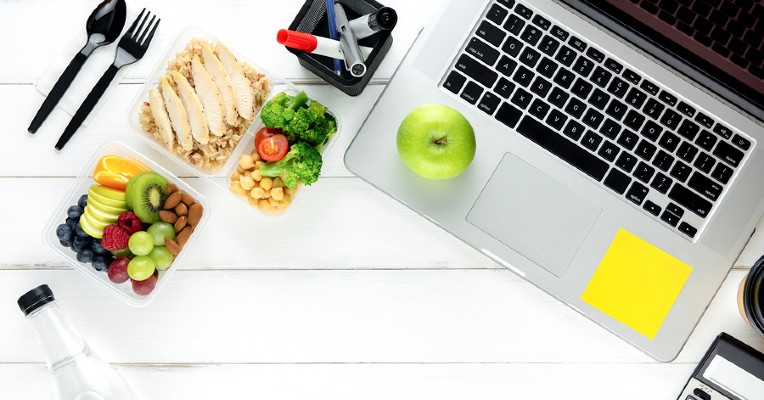It’s hard to resist the temptation and ease of ready-to-eat meals and snacks. But those highly processed foods are wreaking havoc on our health and causing us to gain weight. A diet high in processed foods increases the risk of obesity, metabolic syndrome, high cholesterol, and high blood pressure. Perhaps it is time to get back to basics and eat better. With a plan and a little extra effort, eating fewer processed foods can help us live healthier, longer lives.

Download On Tack with Barix: How to Get Back to Basics and Eat Better
How Did We Get to this Point?
As your mothers and grandmothers entered the workforce, convenience foods were introduced to free them from time consuming meal prep. Packaged foods, quickly prepared with a long shelf life, changed the way Americans ate. Since that time, manufactures have fine-tuned processed foods to make them more desirable than ever, fast food restaurants have popped up on every corner, and eating a highly processed diet has become part of our culture. So much so that, the typical diet is made up of 60% or more highly processed foods.
 What’s Wrong with Our Diet?
What’s Wrong with Our Diet?
Everyone eats this way. What’s wrong with it? Unfortunately, plenty–highly processed foods decrease the feelings of fullness, encourage faster eating, cause inflammation, raise cholesterol, and lead to weight gain. They contain too many additives like fat, sugar, salt, colorings, and emulsifiers. They lack fiber, vitamins, and minerals.
Once Thought Safe
Just look at the addition of emulsifiers alone. These ingredients are added extensively to our food supply. They are substances that help give foods a smooth texture and consistency. Many processed foods contain emulsifiers to keep ingredients from separating, improve the texture and taste, and increase shelf life.
Emulsifiers provide wonderfully smooth, great tasting foods and were considered safe; non-toxic. But now, years later, new research indicates that common emulsifiers like carboxymethylcellulose, polysorbate 80, carrageenan and others are linked to changes in the gut bacteria that can lead to inflammation throughout the body. This inflammation contributes to a wide range of health concerns including high blood pressure, inflammatory bowel disease, metabolic syndrome, obesity, anxiety and cancer. And that’s just one of many added ingredients found in highly processed foods.
Do Processed Foods Really Cause Weight Gain?
It seems so. Put to the test, 20 healthy adults ate a highly processed diet for 2 weeks and a minimally processed diet for 2 weeks in a controlled setting. The food offered on both diets had the same number of calories, sugars, fiber, fat and carbohydrates and the participants could eat as much or as little as they wanted. While eating the highly processed diet, participants ate about 500 calories more per day and over the course of the 2 weeks, gained 2 pounds. While eating the minimally processed diet, they lost 2 pounds.
If you keep good food in your fridge, you will eat good food. –Errick McAdams
Are you Confused?
The food industry is large and powerful. They manipulate government policies, scientific studies, and confuse the understanding of what is healthy and what is not. It’s important to understand that their goal is not the health and well-being of the public, but the bottom line of their balance sheet. They make products that we just can’t get enough of—those that have almost addictive qualities. And if they can make you believe that they are good for you; better yet.
A Return to Whole Foods
Fresh, clean, unprocessed foods can help us lose weight and have fewer health problems. A healthy eating plan is plant-based and made up of vegetables, fruits, beans, whole grains, water, nuts and seeds. It can also include lean animal protein sources. A whole foods diet is higher in nutrients and fiber. It is lower in processed fats, sodium, added sugar and unhealthy additives, like some emulsifiers.
Examples of getting back to basics include eating food in its closest-to-nature form (an apple instead of sweetened applesauce), preparing and cooking foods at home and shopping at local produce markets.
The Value of Family Meals
Something as simple as regular family meals can impact kids in big ways–better grades, better vocabularies, and less risk of using drugs/alcohol/tobacco, having eating disorders, and being depressed. Those are some pretty big returns for something so basic. Not only do family meals provide a sense of stability and belonging, they provide better nutrition than meals eaten out. At home meals tend to include more vegetables, fruit, and whole grains and fewer carbonated beverages and less fat than meals eaten out.
Success is the sum of small efforts—repeated day-in and day-out. —Robert Collier
 How to Make it Work
How to Make it Work
All of these intentions to get back to basics and eat healthier foods are great, but what about putting it into practice? Who has the time, the energy, or the money? The good news is that, it might be easier than you think. Start with small steps and build on your efforts. Sitting down together as a family twice a week is better than not at all and eating fresh, healthy food for one meal a day is a good start. Here are some ideas to help you overcome obstacles that may get in your way.
Time. You can actually save time when you plan and meal prep. Think of the time you’ll no longer wait in fast food lines or making endless trips to the grocery store.
- First and foremost, plan ahead. Get out a calendar and plan meals. Then make a grocery list and shop once for the week.
- Take advantage of the convenience options offered in the grocery store produce and frozen sections, such as fresh-cut or frozen (without additives) vegetables and fruit.
- Use the slow cooker regularly—so nice to walk in the door to a hot delicious meal.
- Intentionally cook extra and freeze leftovers or use in another way later in the week. For example, bake chicken breasts once and then serve baked chicken breasts, chicken enchiladas, and chicken salad, all from baking chicken one time.
- Rather than shooting for the perfection of cooking everything from scratch, start by preparing meals with a combination of prepared foods and cooked-from-scratch foods.
Schedules. Crazy schedules may prevent family members from sitting down together. Consider having breakfast together. Or schedule two nights during the week and make an extra effort on the weekends.
Picky Eaters. Whether it is your youngest child or your spouse, a picky eater can be a challenge to feed. Try to offer a favorite food along with a new food. Let the picky eater help to decide on the menu and help with preparation. Make the food interesting by using a variety of colors, shapes and even by giving foods fun names.
Culture. In our culture, it is acceptable to eat a lot of fast food, highly processed foods, and restaurant meals. In some cases there is an expectation of going out with co-workers to lunch rather than brown-bagging it. Consider bucking the system or compromising by going out once a week and bringing your lunch in the other days.

Cost. Preparing healthy food at home will work into your budget if you plan well, stock up on foods on sale, and minimize waste. It’s true, cheap, highly processed food can cost less. Using a little creativity will move you well beyond sugar-coated cereals, pizza rolls, and bologna as staples in your home.
- Cook extra and freeze leftovers.
- Buy in bulk and make your own single-serving portion packs.
- Buy bottled drinks at the grocery store in bulk rather than from a vending machine or convenience store and save over $1.00 per serving, or better yet buy a reusable bottle and fill it at the drinking fountain.
- Take snacks with you to save money and to stave off the lure of vending machines and fast food.
- Use coupons.
- Try store brands; many products are just as good.
- Stock up when items are on sale.
- Buy produce in season.
- Stick to your list and don’t shop when hungry.
- Eat meatless a few times each week using beans, eggs, or dairy for protein.
- Think twice before buying—is this something that you really need?
Take care of your body. It’s the only place you have to live. —Jim Rohn
The Bottom Line
Chronic diseases are overwhelming our healthcare system, but the huge majority of chronic diseases can be prevented or even reversed with lifestyle changes. Changing the way we eat will take a major shift. It will take a willingness to not settle for a prescription to treat disease, but instead to begin to think of food as medicine. We each have the power to change our health, to maintain the weight lost with weight loss surgery, and to have a brighter future. You can do it meal by meal with the foods you choose to prepare and eat. Now that’s encouraging.



